Suwon’s Palace and Fortress
Suwon, South Korea, a city with more than a million inhabitants, is a separate city from Seoul, but it’s been swallowed up in the post-Korean War urban sprawl, so that it’s in the same metro system.
Getting to Suwon from the center of Seoul involves a very long metro ride: more than an hour, and that’s still nowhere near the end of the line. That shows how extensive the metro system is, and how big Seoul has become. Getting off at the Suwon station, you still have to get on a bus to get to any of the sights.
I decided to go to Suwon because it’s a UNESCO World Heritage site, and the only remaining complete walled city in South Korea, with an impressive palace and fortress walls from the late Josean Dynasty. What I didn’t know was that it’s also home to the Mr. Toilet House Museum, but I’ve already posted about that!

King Jeongjo (1752-1800) was responsible for building both the palace and fortress when he decided to move the capital to Suwon, so these buildings, dating to the late 1700’s, are distinctly younger than any of the palaces in Seoul. Apparently his desire to move there had to do with court politics after his father was killed by royal decree from his grandfather. Not surprisingly, he didn’t trust the court officials who condoned this assassination, and wanted to reform the court. In Suwon he could be near his father’s tomb, where he worshipped, and worked to clear his father’s name. He built the fortress to protect the tomb, but died at a relatively young age under suspicious circumstances.
Hwaseong Haenggung Palace
Hwaseong Haenggung Palace follows the architectural style of the earlier palaces in Seoul, with ceremonial halls; living quarters for royals, concubines, servants and government officials; a shrine; and a garden for quiet contemplation.
It’s distinctly smaller than at its height, when it had almost 600 rooms. The familiar story happened here too: the Japanese occupation that began in 1910 led to the destruction of much of the palace, and it was just rebuilt in the 1990’s.
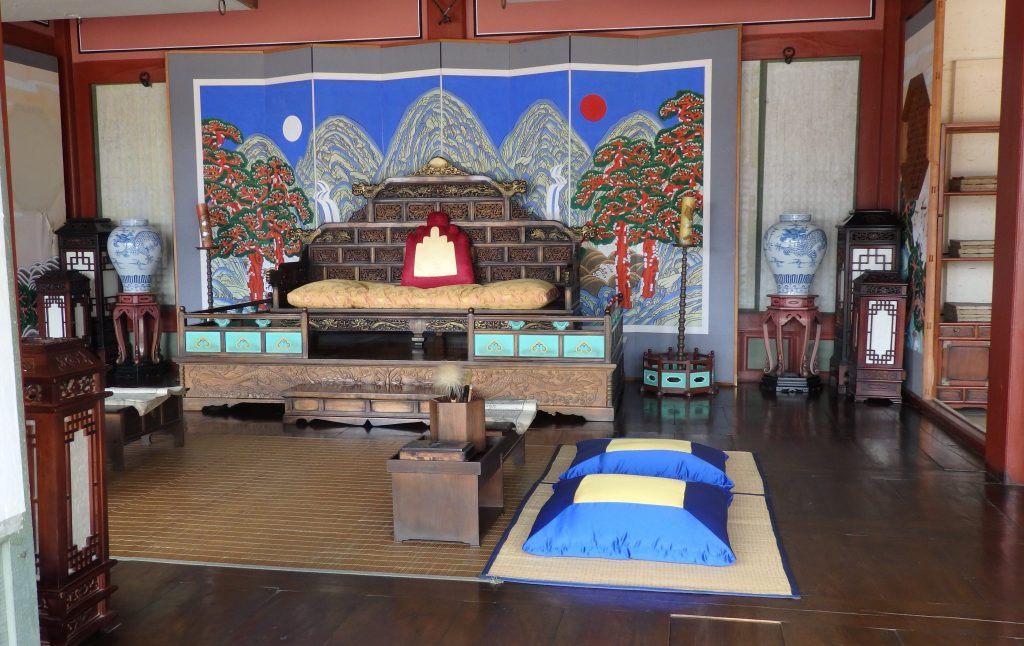
What makes this palace special, however, is the furnishings inside, and the set scenes that have been created in some of the rooms to allow visitors to see what palace life was like.
For example, one scene recreates the banquet Jeongjo held for his mother, which included 12 appetizers, 70 main dishes, and 42 flower decorations. Some of the smaller offices and residential rooms show servants or officers at work.
Suwon Hwaseong Fortress
The dirt embankment around the city, along with the stone fortress walls and wooden guard towers that top the embankment, have been rebuilt. Of course, today it only encloses a small part of the city, but most of it is walkable.
I did some parts of it, but the heat and humidity got to me, so I gave up on the idea of walking all of it. If you visit in a cooler time of year, I think it would make an enjoyable all-day exploration.
One of the many structures along the fortress walls, Seojangdae Command Post stands very high on a hill behind the palace. Supposedly, the king trained his soldiers here himself. (One wonders how seriously professional soldiers would have taken this. Perhaps out of necessity they humored him into thinking he had anything to teach them.)
Sojangdae Command Post consists of a watchtower which looks a lot like the sorts of pavilions I’d seen in other palaces in Seoul. Just next to it is Seonodae (Western Crossbow Platform), a structure that looks distinctly more military: a simple raised platform made of stone, with stone steps leading up to it, which allows a 360 degree view of the surroundings.
Enjoy the view and catch your breath at the top, and then you can walk around more the fortress wall from there. Or you can take a tourist trolley (with an intense dragon’s head at the front!) from just below the command post to see parts of the walls and some of the fortress gates more easily.
Rather than either of those choices, I walked down the hill to Daeseungwon Temple, which had caught my eye because of the enormous golden Buddha beside it. The entrance gate is ornate and beautiful. Inside the small temple underneath the golden Buddha sits a lovely smaller Buddha statue with an amusing picture behind it.
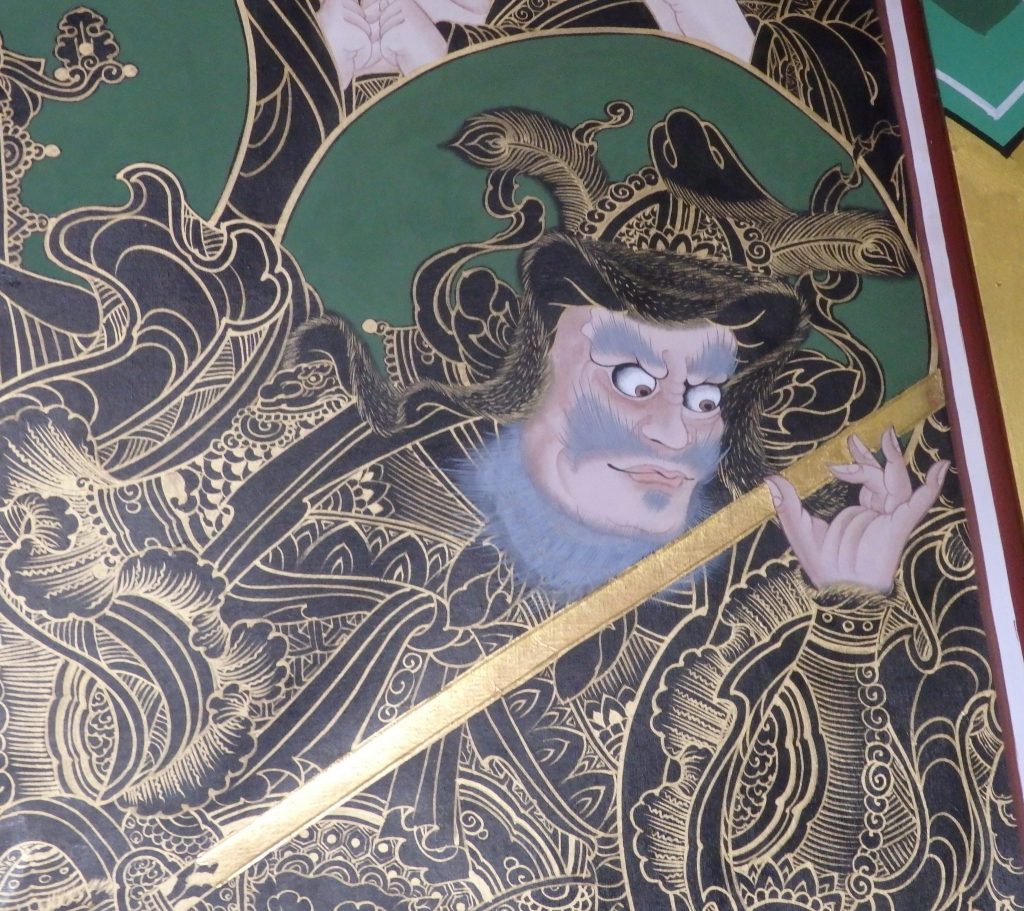
One of the more impressive structures along the fortress walls is Paldamon. Paldamon looks very impressive, but sits in the middle of a traffic circle. Janganmun Gate, at the other end of the same road, can be visited, along with many more, if you’re up for lots of walking. There are four main gates, and many smaller watchtowers, bastions and platforms of various sorts.
Suwon is certainly worth a visit and could be done in a long day trip on the metro from Seoul. However, it’s a bit of a hassle, with first a long, boring metro ride followed by a bus trip to the palace. I’d suggest staying a night or two in Suwon, as I did, so you don’t feel you need to rush in order to see it all.


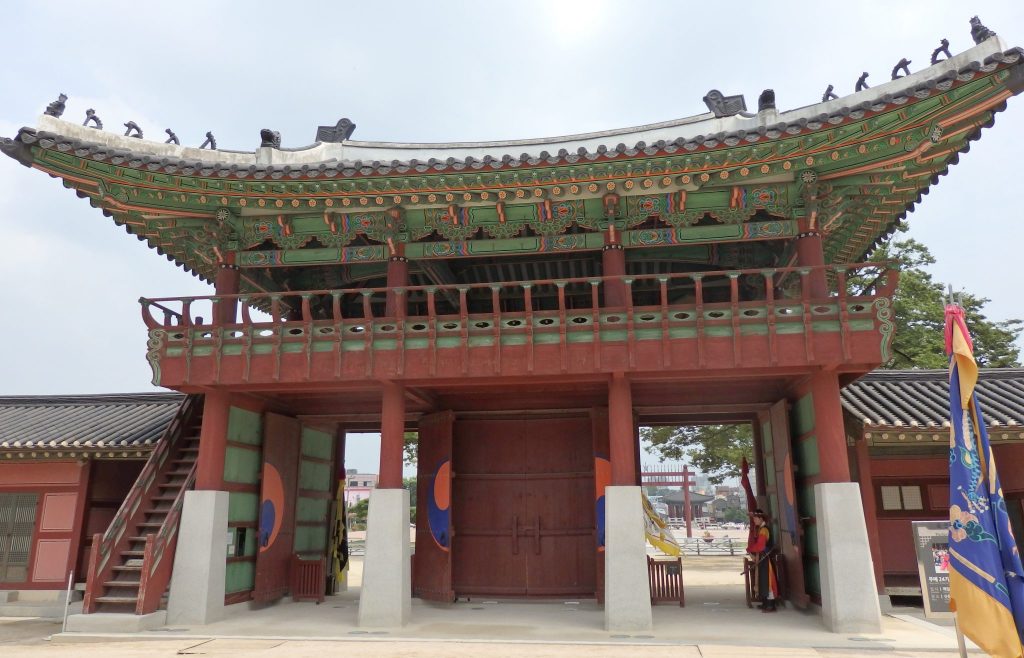
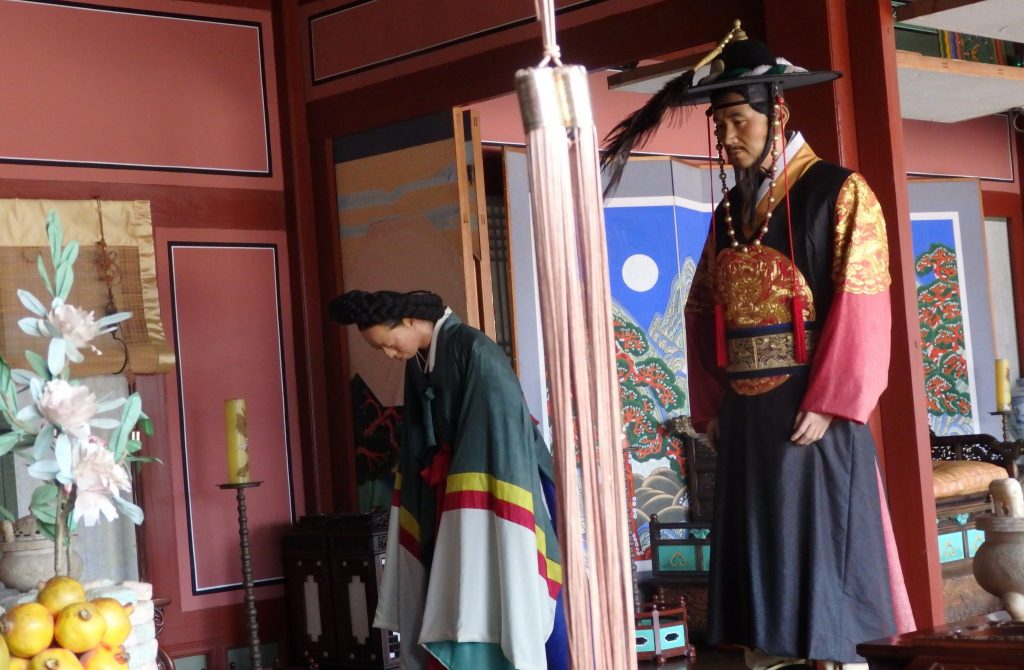
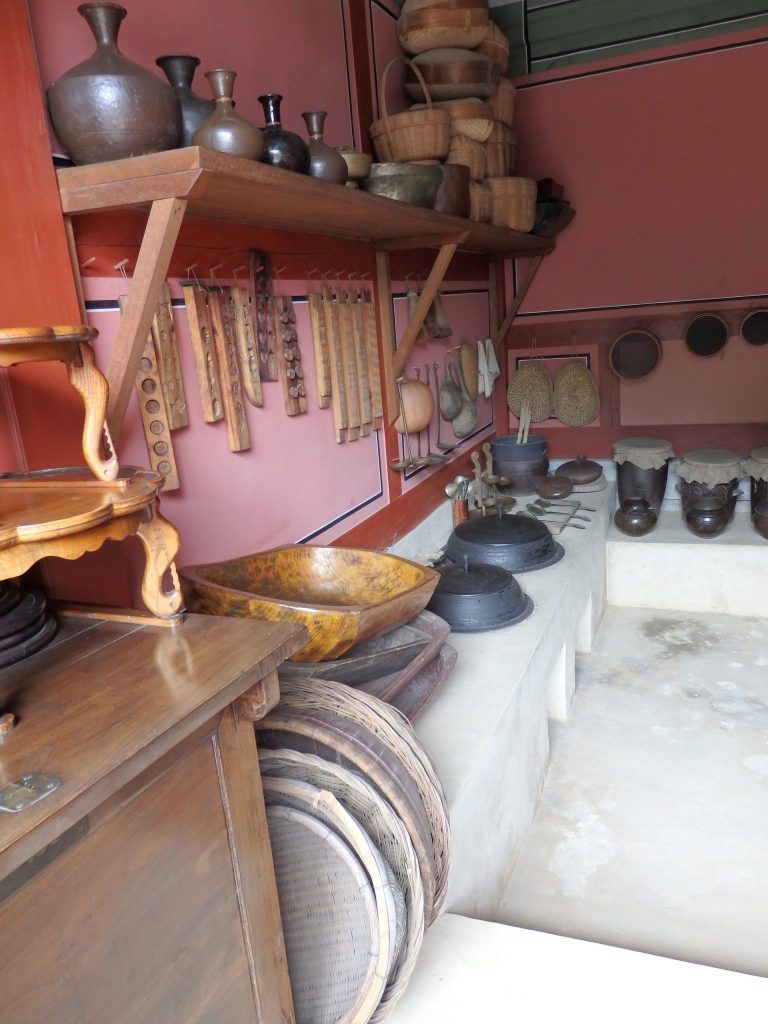
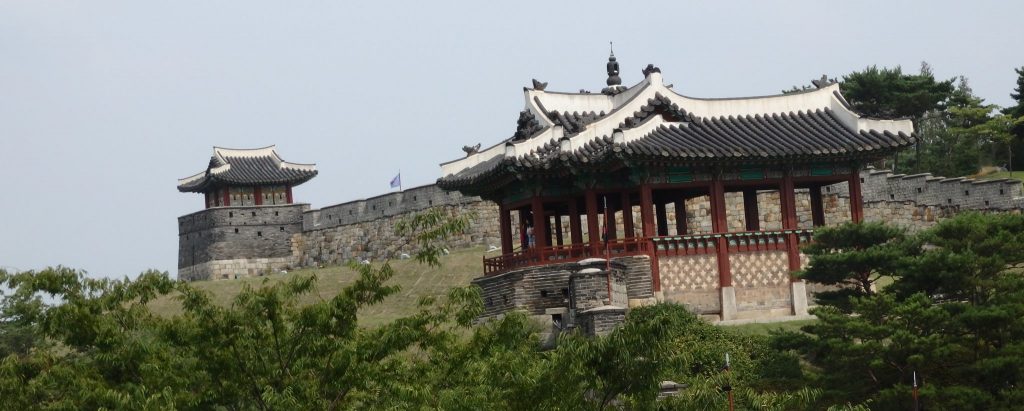

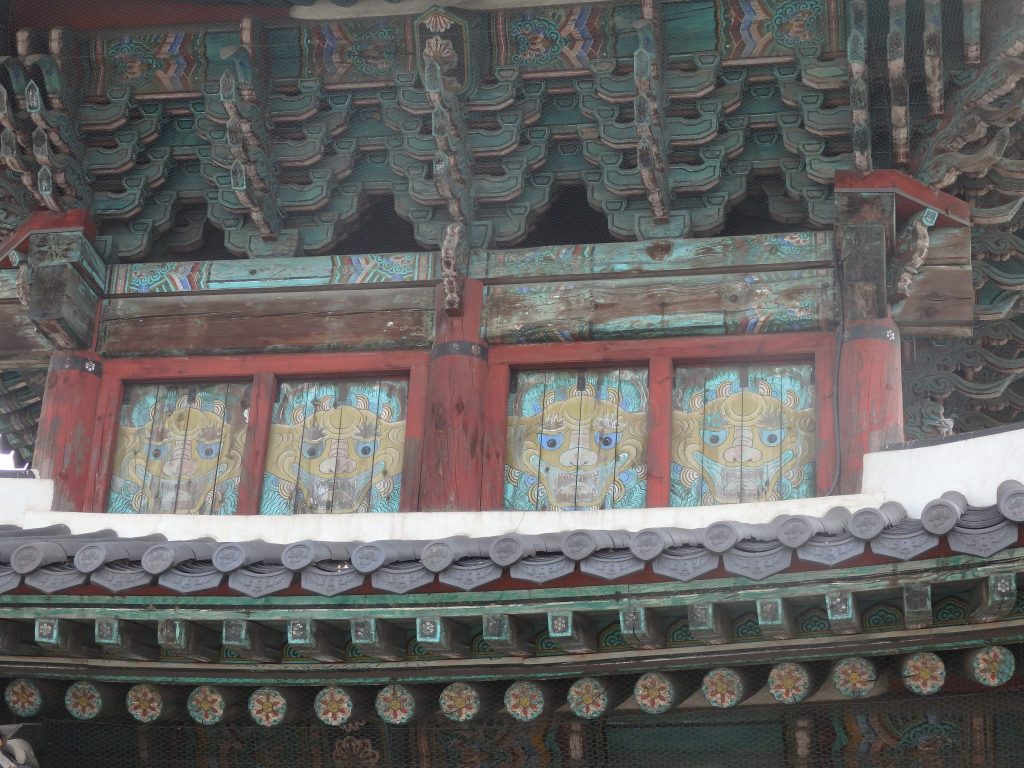

The more I read about Korea, the more I would like to visit.It sounds like staying in Suwon would definitely be the way to go.
Korea is fascinating. I definitely recommend it! I enjoyed the fortress, the palace, and the toilet museum in Suwon, and I’m told the galbi, a marinated beef dish, is particularly good there, though it was outside my budget. Suwon is worth a couple of days.
Rachel, This is one of my favorite places in Korea! It is gorgeous, you can walk the walls, and it is so colorful. Glad you made it there!
Thanks for linking up with #wkendtravelinspiration!
I agree! Even if it is a bit of a chore to get there.
I’ve never heard of Suwon but it looks fab. I have a sub-list on my bucket list to visit as many UNESCO heritage sites as I can. I can imagine that it would be a nice break away from the centre of Seoul to stay for a couple of nights.
I have to say it wasn’t any kind of out-of-the-city break. It’s still a city, or rather an extension of Seoul, both inside and outside the fortress walls. I love visiting UNESCO world heritage sites, and I’d love to build a year-long trip around them!
What an interesting place! I love UNESCO heritage sites and historic places in general. Your explanation of the statues on all the palaces is a great thing to know. Your photos show wonderful details. It definitely sounds like a place I would enjoy visiting one day. Thanks so much for sharing!
Thanks! Glad you enjoyed it!
We always keep our eyes open for the opportunities to see UNESCO WHS and Suwon looks like it’s well worth the effort and time spent for a lengthy visit. Loved seeing your photos of the Hwaseong Haenggung Palace with it furnishings and beautifully dressed inhabitants which make it easy to picture the day-to-day activities that occurred within its walls. The more I read about Korea the more I want to pack a suitcase and just go!
Go! It’s an easy place to travel, i.e. with a good train and metro system, and you can usually find someone who speaks English. And it’s interesting, and the food is good!
It sounds like we’ve been hanging out in the same part of the world, as we’re currently in Busan. I haven’t been to Suwon but it would be great to see a furnished palace like Hwaseong Haenggung. There’s a lot you have to imagine at most Asian palaces which are usually empty.
Yes, that’s why I liked it! As palaces go, I liked Changdeokgung in Seoul the best, but this one was interesting because of the furnishings. It was also much less touristed, and the fortress walls and gates, etc. are interesting. If you go, don’t forget the toilet museum as well!
What a fantastic tour, it really has been lovingly restored, beautiful job. It almost looks so original!
That’s true for all the palaces I visited in Seoul too. Clearly no expense was spared to restore them completely using traditional materials so that they would be as authentic as possible. But as far as I know, only the fortress is a world heritage site, and, of the palaces, only Changdeokgung in Seoul.
Hi Rachel – I am so impressed by all that you managed to see in Korea even as you were sidelined by your neck issues. This is a beautiful palace. I am most intrigued by the everyday details and the paintwork that you featured. I’ve never particularly wanted to visit Korea, but my interest is definitely piqued. 🙂
Yes, I missed about a week in total, with some days when it just hurt too much to enjoy any sightseeing and I just holed up in a hotel room. Once I got the right medicine from a doctor who spoke English, it didn’t hurt at all anymore, but I stayed near Seoul to stay near that doctor. I chose Korea fairly randomly, as a place I’d heard next to nothing about, but seemed like it would be relatively comfortable for a first solo trip.
Hi Rachel. Count me among those who tries to visit all the UNESCO sites she can. Call me silly but even so it never occurred to me that Korea ever even HAD walled cities, so Suwon comes as a complete surprise.
Between the fortress and the toilet museum I can see why it might warrant a two-day visit. Are there many hotels nearby?
I don’t know if there are many, but I stayed in one inside the fortress walls that was walking distance from part of the wall and also the palace. It was comfortable but with some problems that will be in another post soon! And there’s a hostel, I noticed, right next to the palace entrance.
The fortress is very impressive, would love to see it. Hopefully we can return to South Korea soon because we have so much more to see there.
If you’re going to be in Seoul anyway, this is worth a visit!
Korea always interests me as my aunt and uncle lived there after the Korean War. He was doing something that had to do with getting the country back on track- I was too young to know what. Suwon looks great- I’m a sucker for UNESCO Heritage Sites.
Me too! I’d love to see every single one! I’ll be posting soon on my visit to the DMZ, which might interest you and your aunt and uncle.
Such an impressive site… can imagine the view from the top would be spectacular! Would love to visit some day.
loved reading your post. I was looking for some posts about Suwon Hwaseong Fortress written by someone who is not Korean because I am writing a text for English coursebook for middle school students in Korea. Your post is very helpful. Thanks a lot. I also want to thank you for making other people want to visit Korea.
Glad it’s of use! Please, if you quote from it, give me credit in your coursebook!